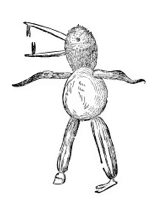What Pictures Cannot Do: An Interview with
Lydia Wilson on the History of Writing

Australia Northern Territory 'Moon Dreaming Site', Episode 1 Word History, Photograph: Crew Dox. © Dox Productions.
Lydia Wilson is a British researcher and scholar of the Middle East currently affiliated with the Universities of Cambridge and Oxford in the UK, as well as the City University of New York. Her work focuses on the motivations of participants in violent conflict. In addition to briefing the UN and other governmental agencies internationally, Wilson regularly appears on news and media outlets to discuss current events and politics.
Wilson also edits the Cambridge Literary Review and has published many essays and articles in a host of magazines and academic journals, including the New York Review of Books, Nautilus, and The Nation. She is at work now on a book about extremism, which draws on her field research interviewing "Islamic State" fighters.
We spoke to Lydia Wilson by phone in mid-November 2019 to discuss her recent project with the BBC: Word History, a three-part television series about the history of writing. Wilson is the narrator of the show, guiding the viewer from the early pictorial writing systems of the Aboriginals in Australia all the way to contemporary China, where teenagers congregating in a café text in a twenty-first-century amalgam of emojis and the Roman alphabet.
As you might imagine, representing the whole history of writing is a massive undertaking at any scale, and trying to distill the history to only the most camera-ready moments is like trying to squeeze the entire Library of Alexandria into a single Manila folder. Perhaps our conversation will give some sense of this conundrum: We covered quite a range of topics, spanning the origins of the alphabet, the political implications of script reform within a national language, how many cows it took to print a page of the Bible in the Middle Ages, and the boredom inherent in the process of filming.
What follows is an edited transcript of our call.
David Richardson: How long have you been working on the television program?
Lydia Wilson: It's been over a year now—our first filming was in October 2018. It's been quite a long process. A lot of my research has been put on hold until the major filming trips finish, and I have just started getting back into my more academic research a couple of months ago now.
DR: How much filming do you have left?
LW: We just have a few pick-ups left, so I'm in Leiden in a couple of weeks and then we have some shooting to do in London—some last minute, British-Museum-type pick-ups. Now that everything has virtually been edited we can spot a couple of little places where an additional shot could be useful, and that's all there is left now.
DR: Is this your first foray into television work of this kind? I know you've been on various news outlets in relation to your research on the Middle East.
LW: Yes! It was very fortuitous and it's been so much fun, and really wonderful to do something so different, actually. It took a little bit of getting used to, I have to say—I don't know that I've ever done something that has involved so much boredom combined with being so terrifying!
DR: Could you expand on that, the boredom and the fear?
LW: Well, I got used to the fear pretty quickly, to be completely honest, with the help of a really nice team—the cameramen and the sound person, they were excellent. I got used to the fear because that's just practice. The boredom I established strategies for.
Because I hadn't had the experience before, I didn't really understand the extent of how much waiting is involved in filming. I would be ready to do my bit, getting more and more nervous, rehearsing it in my mind, standing in the same position, while the director and the director of photography would start shifting the shot by a micro-centimeter, and then, of course, when you've shifted the camera by a centimeter, the background has to change, and then there's a light in the way, and then they have to relight it because they've taken the light away from the background, and that can be twenty minutes, and I'm just standing there getting more and more nervous. But when I finally figured out that that was normal, all I needed to do was to go somewhere with my notebook and sit there and say, "I'm here when you need me." So it was just about learning the strategies. I just didn't realize how much time was spent not actually filming on a set. And it's tiring hanging around—more tiring than I would have imagined.
DR: Yes, boredom can be quite exhausting.
It's extraordinary thinking about the ratio between one minute of film and the amount of time it took to produce, shoot, and edit that same minute.
LW: That would be horrifying to know, I reckon.
DR: I often think about the relationship between the time it takes to write something and the time it takes to read it, and that causes me great consternation.
LW: Yes, I don't want to think about that either!
DR: When you would tuck away with your notebook, rehearsing your part perhaps, was it a script that you were consulting? One you had written? Which is to say, what was your role in writing what you wound up speaking on camera?
LW: Actually, there wasn't a shooting script, which is an interesting way of doing it. I realize now it's unusual, and there are pros and cons—it's much more demanding on set not to have a script, but on the other hand you can respond to the people you meet on location that day, the people we interviewed. You don't have the rigidity of sticking to something. We quite often found out very interesting things just while we were on location.
The program, the series, had been in development for a long time without my involvement—I think it was over ten years. So a lot of the ideas were very familiar to the production team, but I had to get up to speed on them much quicker, and because I was the only person on the team with a background in history, that kind of proved to be somewhat useful in the writing.
DR: When you began working on the project, were you shooting more or less immediately? Which is to say, were you having those discussions right off the bat? Or had you been consulting materials that had been prepared in advance?
LW: There had been a screen test—because I hadn't done anything like this before, the BBC of course needed a screen test. That was way back in July 2018. And then we didn't actually sell the series to the BBC for a while, but I was still working on the ideas and doing some background reading until the first shoot, which was the middle of October, when we had a few days in Cambridge, UK. So I'd had a little bit of time to get my head around everything, but it's just an enormous subject. We go from a pre-literate culture right the way through to digitization, and up to emojis in the present day. I couldn't prepare for everything, I just read frantically as I went.
DR: Are there books or articles which were particularly helpful? Or of especial interest?
LW: Andrew Robinson's The Story of Writing: Alphabets, Hieroglyphs and Pictograms was one source. As for anything else, it depends on the country, we spanned so much, I must have read dozens of them, but often only tangentially related. For example, Irving Finkel (a curator in Assyriology at the British Museum) has written very accessible books on cuneiform; for Egypt I read some of the excavation reports from the early twentieth century (Flinders Petrie's own) and Alan Gardiner's subsequent decoding of the script, but also got hold of modern textbooks on hieroglyphs, and read Orly Goldwasser and Pierre Tallet's work (both of whom we interviewed). For Uzebkistan there was less to go on that was specifically about writing, but I read a lot of literature and work on the Sufism of Central Asia (Platonov, Ismailov; the first a Soviet era writer; the second a contemporary exile living in London), because of the relevance to the history of writing. For Australia, there was a lot about the importance of the land (Deborah Rose, and even Bruce Chatwin, but more importantly responses to Chatwin). I could go on and on!
My specific background is actually in Middle East studies—I have a PhD in medieval Arabic philosophy. I was giving advice on the role of writing in the Arab traditions, including calligraphy and the spiritual side of writing—for certain traditions like Sufism, there is a very mystical aspect to the Arabic language, for instance.
I mean, nobody is going to be an expert in all of this, and I had that kind of Islamic/Arabic side of the picture, as well as the general training in history.
DR: Did an interest in the origin of writing or the history of writing figure for you in your graduate studies?
LW: No, not at all. I was coming in having studied the tenth century, by which time writing was pretty established.
DR: Can you sketch out for the readers of jubilat the basic trajectory of the series? How many episodes, and is it organized chronologically? Or is it more place-based?
LW: So it's a three part series, taking in the history of writing. It is broadly chronological, but it's also thematic—that's just the way it broke.
The first episode covers the emergence of writing. Now, it seems as though writing came about independently in four separate places. We start with the Aboriginals in Australia, who have the most amazingly sophisticated and complex society. They have more social ties and rules governing those ties than any society I've been in, and yet, they do it all through oral culture. They transmit everything through song, so it's not necessary to have writing to have a very complex society. But there are some things that those societies will never do as a function of their lacking writing. At this point the series goes to Egypt.
In order to build the pyramids, you needed an extensive system of food redistribution and taxation, and you cannot run a bureaucracy like that without some form of record keeping. That's when you start getting the first marks on the first materials—it's to do with business transactions, or taxes, IOUs, those sorts of things. There's something that represents numbers and something that represents barley, or bread, or cows.
But fascinatingly enough, it emerged independently in China, Mesopotamia, Egypt, and later in Mesoamerica. It feels as though there is something, when humans gather together in certain sized groups, that promotes this kind of need. But even more interestingly, those four early systems operate identically. Chinese cuneiform, Egyptian hieroglyphics, and Mesoamerican hieroglyphics —they have nothing, aesthetically, in common. The cuneiform is practically abstract, and the hieroglyphics are beautifully detailed with pictures, but they are operating in exactly the same way, all four of them. Again, there's something about the common problems that humans are facing in these civilizations which leads them to solve them in the same way in order to capture their spoken language in a written format.
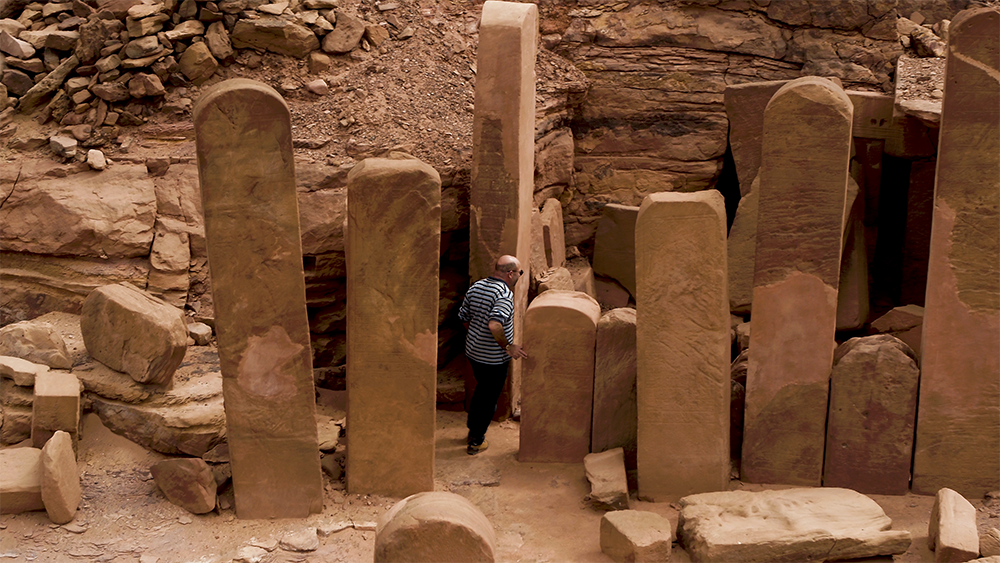
Pierre Tallet among Stelae, ruins of Hathor's temple / Serabit El-Khabim, Episode 1, Word History. Photograph: Crew Dox. © Dox Productions.
DR: Could you give a little primer for how those systems work?
LW: You start with pictures. You quickly realize, though, that there's a lot of things pictures can't do—they can't capture something abstract, and prepositions and time are both very difficult. So there's a step that happens in all four systems: instead of signifying a specific object, the picture is used to represent the sound. This is called the Rebus principle: Instead of having a picture of a duck represent a duck, you take the first letter of the word "duck" and the symbol codes for the sound of that letter, or perhaps the whole syllable. It's that step from symbol-as-picture to symbol-as-sound that allows you to capture a spoken language.
Then, if you're using the symbol for duck to mean both "duck" and "D," you've got ambiguity. So every single ancient writing system we know of adds a form of classifier or determinant, which is something you put either at the beginning or the end of the sentence to show which one you're talking about. If you mean it as a "duck," then you put in the classifier for "birds" so that you know you're talking about a duck, not the sound of the letter "D." These classifiers are unspoken. They are quiet elements of the sentence that clarify any ambiguity.
The inherent ambiguity, however, means that ancient writing systems are actually much richer than our written language—you can write things in different ways, you can pun by using different forms of sound and picture, you can combine them differently. You can say the same thing in a sentence but you can write it differently, which we've lost in our alphabetic system. But, when you write a text message, and you put in an emoji, we've gone right back to those ancient writing systems. We don't speak the emojis, we clarify our emotions. Which is really cool!
Now something extraordinary happened about 4,000 years ago, in roughly 2,000 BC. It was in the Sinai Peninsula, which features in the series. In the middle of the desert on a high plateau, there's a temple to Hathor, the goddess of turquoise—there are turquoise mines all over this patch of the Sinai Peninsula. It was the edge of the known world for the Egyptians, but the turquoise was immensely important to their whole cosmology—you needed it in your tomb, you needed something the color of turquoise, if you wanted to rise again. Turquoise was the color of rebirth, the color of the sky at dawn. So they put a lot of time and effort into mining turquoise, both Egyptians and immigrants from the region. Immigrants traveled from the Levant—they were probably Canaanites. The Egyptians called them something like "Asiatics," generic Easterners, because they came from the east, but we know their language was Semitic and so they were probably from somewhere in modern Lebanon.
These immigrants came and observed what the Egyptians were doing in the temple to Hathor, and one of those things was inscribing the detail of every single expedition, hoping for the goddess' blessing so she would reward them with lots of turquoise. And so they looked at all these hieroglyphics and they began scratching their own. They were speaking a different language, and so they simplified the marks down—they copied the action of writing, but in a far more spare manner, and they missed out the symbol-as-picture step. They just went straight for the sound, and as a result they invented the alphabet. On the trailer, our contributor archaeologist Pierre Tallet, says, "and here we have one of the first A's in history, and here we have one of the first B's in history."
I was there! I touched the first alphabet in the world.
DR: Wild! I imagine there must have been countless moments like that in the filming of this project, moments when you felt exactly that sense of awe. Can you think of another one that was particularly exciting?
LW: Uzbekistan. I didn't even know where the Osman Qur'an was, which is the very first written Qur'an ever—it's famous in Islam. Osman was the third Caliph. In the seventh century, the very early days of Islam, he noticed that the Qur'an recitations were proliferating and he asked for it to be written down. And the Osman Qur'an is in Tashkent, in Uzbekistan. We filmed it, and that was extraordinary.
Filming the little sphinx from the Sinai, from Serabit el-Khadim, in the British Museum was also amazing, because it's the key—it's the Rosetta Stone of the alphabet. The little sphinx is how we know what these scratchings on the mines were, because there's a chunk in hieroglyphics and a chunk in this early alphabetic script and so we can figure out what's going on. The hieroglyphics spell out the name of Hathor, while in the alphabetic script they've scratched the name of their goddess—it's not Hathor, but Ba'alat, the kind of correlate goddess.
Being in Australia was also phenomenal, just listening to traditional songs.
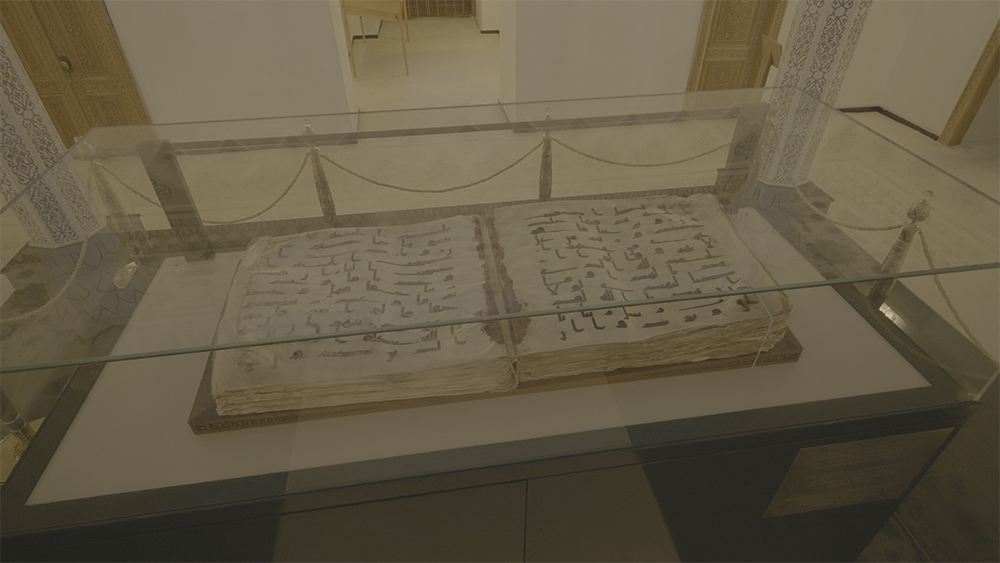
Uthman Qur'an Tashkent, Episode 2, Word History. Photograph: Crew Dox. © Dox Productions.
DR: Perhaps we can pause there for a moment—the series begins in Australia, right? Talking about the Aboriginals?
LW: Yes, we had three days in the northern territories, in the bush.
DR: So that's the opening of the series—Australia and Egypt— and where do we go next?
LW: So we cover all that early writing, and then the birth of the alphabet in the first episode. I think the birth of the alphabet is pretty much where we end the first show, because it took a while for the alphabet to catch on. The Egyptians, for instance, definitely didn't want it—we still have hieroglyphics right up to AD years: There was power in their writing, they weren't keen on the alphabet, on changing their system. Eventually, it did catch on, and it enabled digitization. You couldn't code with any other system. And it enabled printing. This is where the second episode takes off.
The technology of printing arguably triggered major political and religious change in Europe. People like Luther were able to pack up a printing press and put it on a horse—it became so much easier to disseminate ideas. And that had a huge implication for all sorts of areas of knowledge, which means it was a factor in how Europe came to dominate globally, and it was all just an accident of the Latin alphabet, which happens to be more suited to printing (it's not cursive, like Arabic, and it's alphabetic, unlike Chinese). So that's the technology of writing, and we also cover the art of writing, as in calligraphy. With calligraphy we get added meaning: There's the aesthetic meaning, but also in different traditions there is spiritual meaning. In China, for example, it's actually a test of your moral standing, the way you write. Your handwriting was assessed in the imperial exam to show what kind of character you had.
For this second episode, we filmed some wonderful work—it's called water calligraphy, in China. It's like Tai chi in that it is both a physical exercise and spiritual practice. They use enormous paintbrushes filled with water and they paint on the ground. We were there in July, when it's very hot, and the writing evaporated extremely quickly. It's a zen practice—you cannot reflect on your past mistakes or your past glories, you have to live in the moment. It's all drying before them, but they're still writing and writing all over the ground!
So the series goes into all the additional features of what writing has come to mean in a society. Really, it's everything on top of a means of communication.
DR: I love thinking of the water calligraphy, the way evaporation figures as a kind of zen publishing technique. A way to get things out into the world and then to move on.
Can you think of other moments from the series that exemplify the spiritual valence of writing?
LW: We had a wonderful calligrapher in Turkey, in Istanbul—a very traditional practitioner. He told us all sorts of stories. One of the things was that when you are a calligrapher, you keep all your pencil shavings from your whole entire life, and at the end of your life, they burn them to heat the water that washes your body before burial. We watched him fill up this little pot with his pencil shavings.
DR: That's an incredible image, and a beautiful way to think about the work of a writer, that the amount you make facilitates your passage into the afterlife. It's also interesting to think of writers as playing, in part, for the next world.
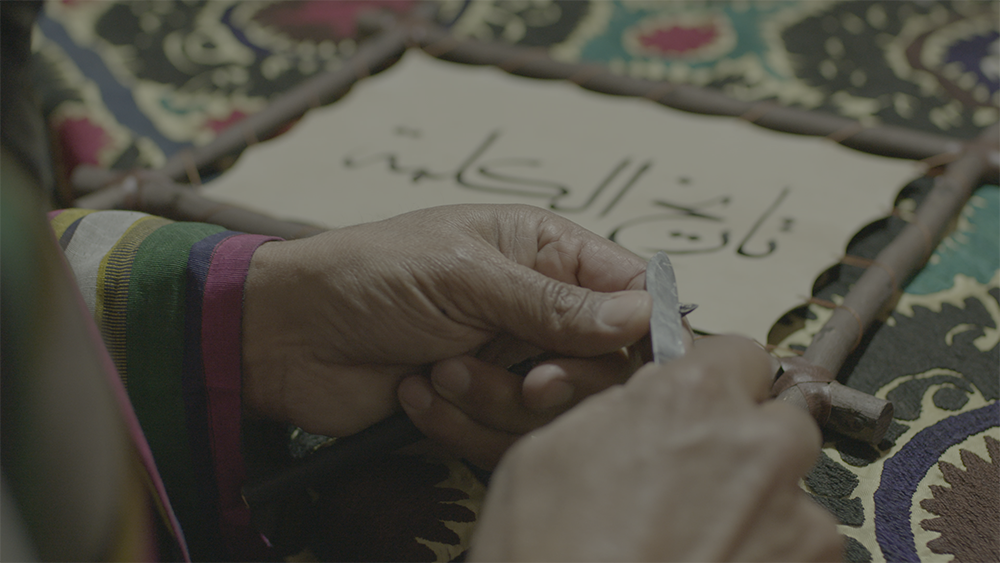
Calligrapher Dzhalil sharpening pencil, Episode 2, Word History.
Photograph: Crew Dox. © Dox Productions.
After covering the very beginning of writing and the alphabet in episode one, and the flourishing of the practice of writing and the technology of printing in episode two, where does the third and final episode take us?
LW: The third episode is entitled "Script as Identity."
What has happened throughout history is that different religions have taken their script across to different parts of the world. In Britain, for example, we wrote in runes for a long time, and even when the Romans conquered the territory, runes were still very common. But with the coming of Christianity runes disappeared altogether. We had the Roman alphabet from that time on.
Similarly, Islam took the Arabic script all over the world. The Turkic people of Central Asia were writing in many different scripts—Sogdian was the one in Uzbekistan, for example, and eventually it was all moved over to the Arabic script, even though the Turkic alphabets aren't very well-suited to the Arabic script. That was recognized by Atatürk in 1928 when he wholesale transferred Ottoman Turkish into Latin letters—there was also language reform, but the script reform was a huge statement of identity. It showed he was pivoting very much toward Europe and away from the traditional seat of the Caliphate, which was what Istanbul had been for over 400 years.
In addition to the profound cultural effect, the Latin script was also a better fit for Turkish. Arabic doesn't include many vowels, and Turkish isn't a Semitic language, it isn't cut out to be expressed like that—there are huge amounts of ambiguity if you don't have enough vowels. And the letters don't match—Arabic has different sounds than Turkish, so there are some letters which just were never used and there were other letters they didn't have. So it could be argued that Latin has worked out better anyway in Turkey.
Script reform in Central Asia has been even more drastic and tumultuous. In Uzbekistan, Lenin's script reform invoked the theory of Turkic solidarity. The first script reform away from Arabic in Uzbekistan was actually to Latin letters because Lenin felt that they should be able to communicate with the Turks, because Uzbek is a Turkic language. So for ten years they had a Latin script. If you think about it, that involves rewriting all the textbooks, rewriting all the street signs, rewriting all the bureaucracy. Then ten years later, Stalin comes in and makes it all Russian script. He changed it all to Cyrillic. And so then for I don't know how many decades, maybe five or six, they're writing their languages in Russian letters. And then comes the dissolution of the Soviet Empire, and all of these Central Asian republics have to make their decision, and they all chose Latin. It's just easier to fit in with the globalized world we live in. So in one century, they've used Arabic, and then Latin, and then Cyrillic, and then Latin again. Which means that you are, in some very fundamental way, cut off from your past. You can't read the letters between your grandparents if you've been educated in a different script. The language is the same, but you can't read it. You cannot go to the cemetery and read your grandparents' gravestone. And that's just one example.
Mao tried to reform Chinese, he tried to bring in some element of Pinyin and it just didn't catch on—Chinese culture is just too much associated with the Chinese writing system. But what Mao could not achieve, even as a dictator, capitalism has, because the kids are all texting in Latin letters. So it is happening now, and it's happening in countries with Arabic script, too. We have a scene in the series with young people in a cafe in Cairo, and a lot of them are texting their language in Latin letters. So there are other script reforms happening now, just not official ones.
DR: Fascinating to lay out that script literacy is, in an important sense, historical literacy, and the switch between scripts conducts an immense amount of power. If your relationship with your past or your tradition is complicated by script reform, you are subject to a kind of statelessness, of the mind but also perhaps literally. Not being able to read your grandparents' letters is such a harrowing example.
LW: Yea, you can't imagine it, can you really?
DR: Not at all. Thinking about familial texts that are in my language but rendered inaccessible to me by virtue of a script change is just so invasive.
So this is all packed into these three episodes, and each episode is a kind of supercut? You move between locations, talking to experts or practitioners, etc.?
LW: Yes, exactly.
DR: How does the series deal with the practice opposite writing: reading?
LW: Yes, actually, that's interesting—we have got a little bit of neuroscience on this count in the show—Tae Twomey, a Japanese scientist living and working in London, features in the series. She tested people reading Japanese in the different scripts that they have (every Japanese person can read in different scripts, like the pictorial Chinese system, and then the simplified system). She conducted experiments on readers, scanning their brains while they were reading the same language in different scripts. She found—and I'm probably vastly oversimplifying—that there are certain pathways in the brain when you're dealing with visual information, and others when you're dealing with audio information (essentially what you're doing when you're reading an alphabet is hearing it and so it goes through the auditory pathway, but you're recognizing the shapes as well, so there is an aspect that goes through the shape-understanding one). When you learn how to read, you're spelling it out, but once you're literate you're combining the sound with the visual recognition of the shape. What she found was that the two different scripts—one strictly pictorial, and one alphabetic—called on both of those pathways to comprehend the text, but there was just a slightly different emphasis on the pictorial for the Chinese characters version. But essentially we all use both. We all hear them in our heads and we all see them on the page, whatever script system we're working with.
DR: In addition to neurological accounts of reading, does the series discuss any history of reading practices? Does it touch on literacy? Obviously there is a huge shift in that second episode with the birth of printing.
LW: The series does not cover it so much, though we definitely cover the literacy aspect of reform, and of course printing did have an enormous effect on it. Well, actually not so much printing as the technology of paper—that has a much bigger effect. After the Roman empire fragmented and lost Egypt, Europe lost its access to papyrus, which is a very, very cheap way of making paper, of making a surface to write on. Europe pivoted away after that and used parchment, which is phenomenally expensive. If you think of a big Bible, for example, you only really get four pages out of one cow. It takes a whole herd of cows to make a Bible in the Middle Ages.
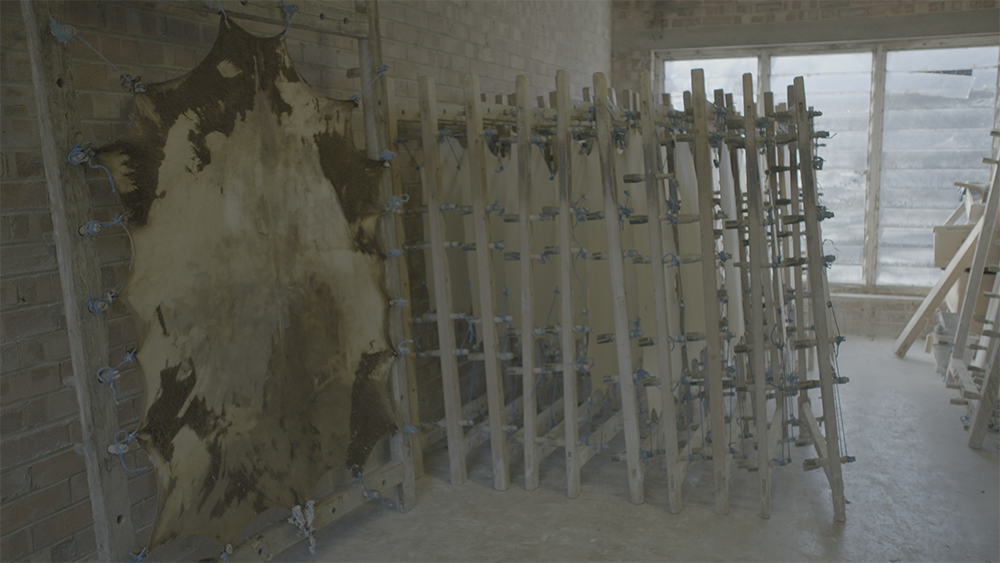
Skins being stretched in wooden frames at Cowley's parchment factories, Episode 2, Word History. Photograph: Crew Dox. © Dox Productions.
To illustrate the difference paper makes, consider this: there were tens of thousands of books in libraries in ancient Rome. One of the biggest libraries in Europe in the High Middle Ages, Cluny, had about two hundred, and that's one of the most famous libraries of Europe! That's a function of the material limit, because you can find a scribe to copy you out something if you have a little bit of money, or you can copy it out yourself if you have the time. But the substrate is a bigger limiting factor really.
Then, with the fall of Constantinople and a load of expertise coming Europe's way, paper got figured out, and things took off again. And printing is the rest of this story.
Essentially, though, literacy is much more about education than any form of writing, as we see in the case of China: literacy rises without simplifying the writing system, through mass education. The same is seen all around the world: the script or technology is never the limiting factor.



